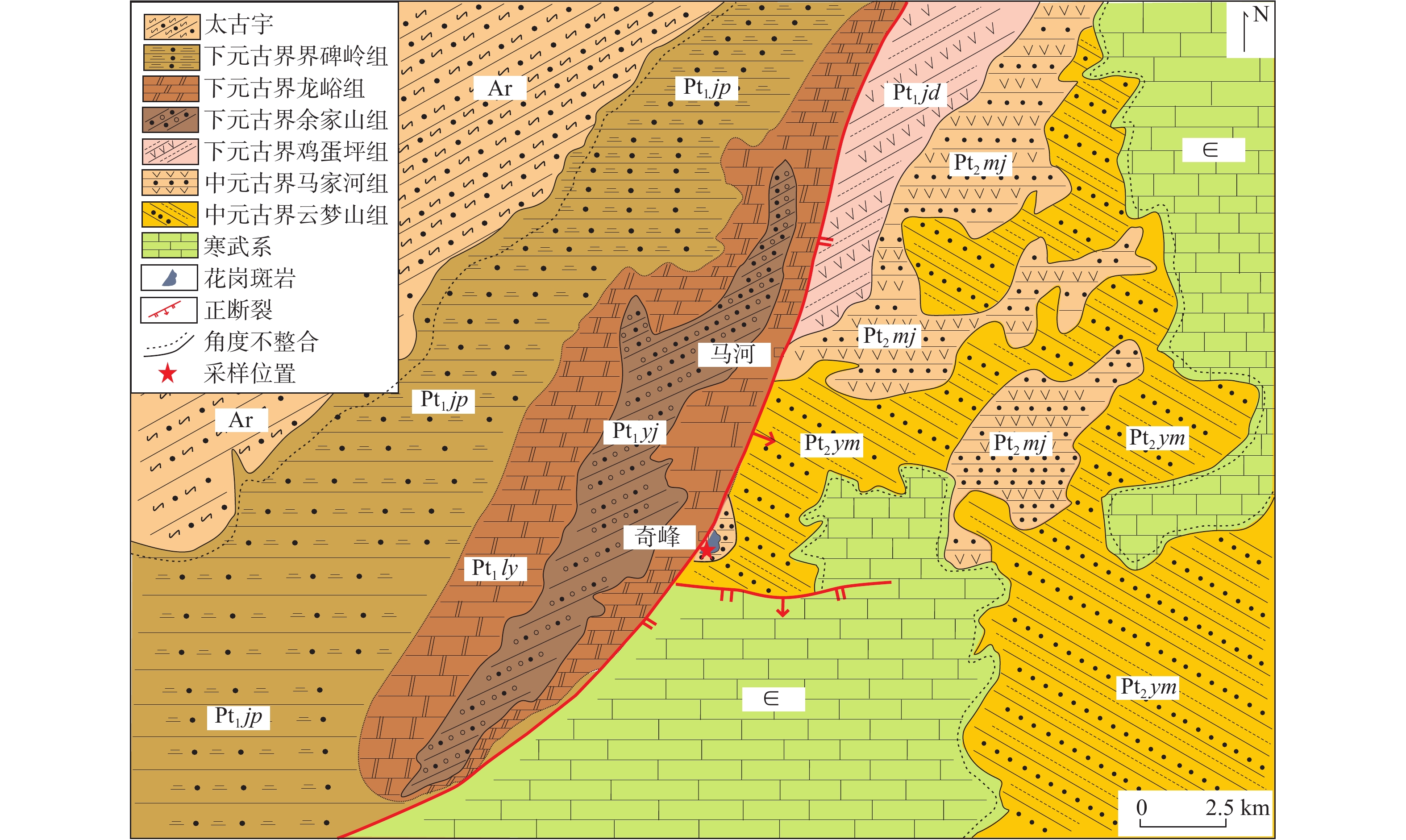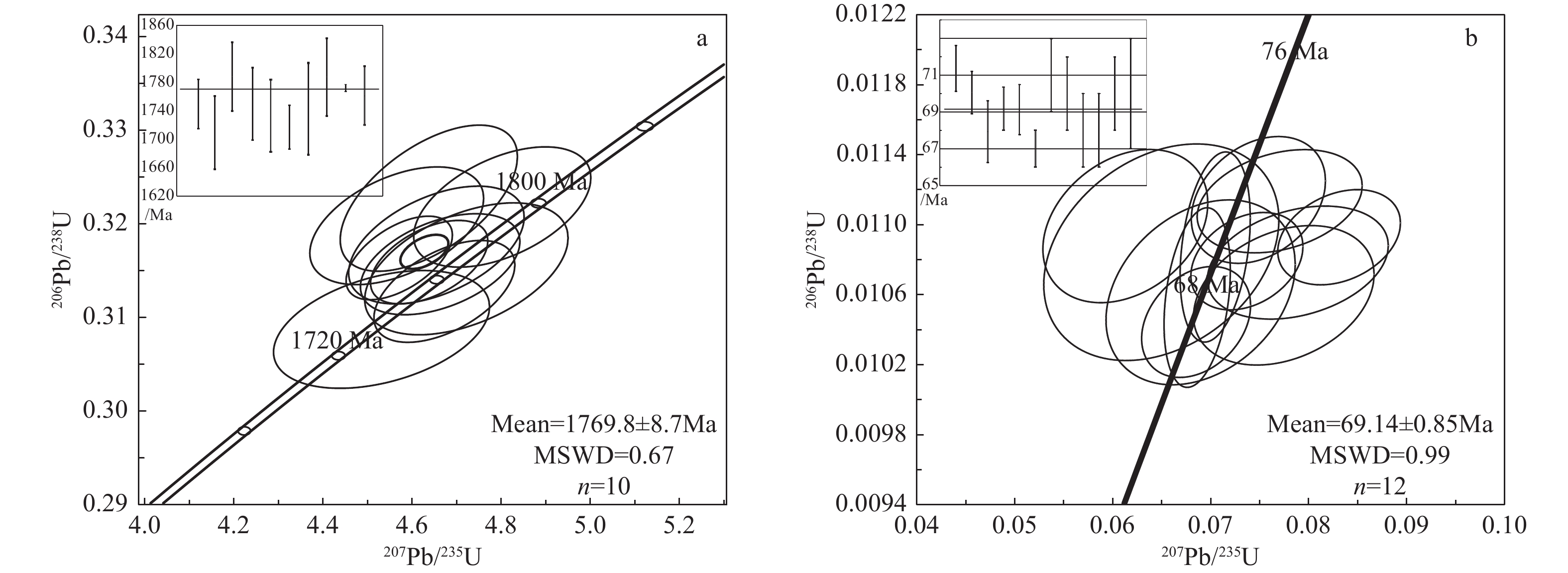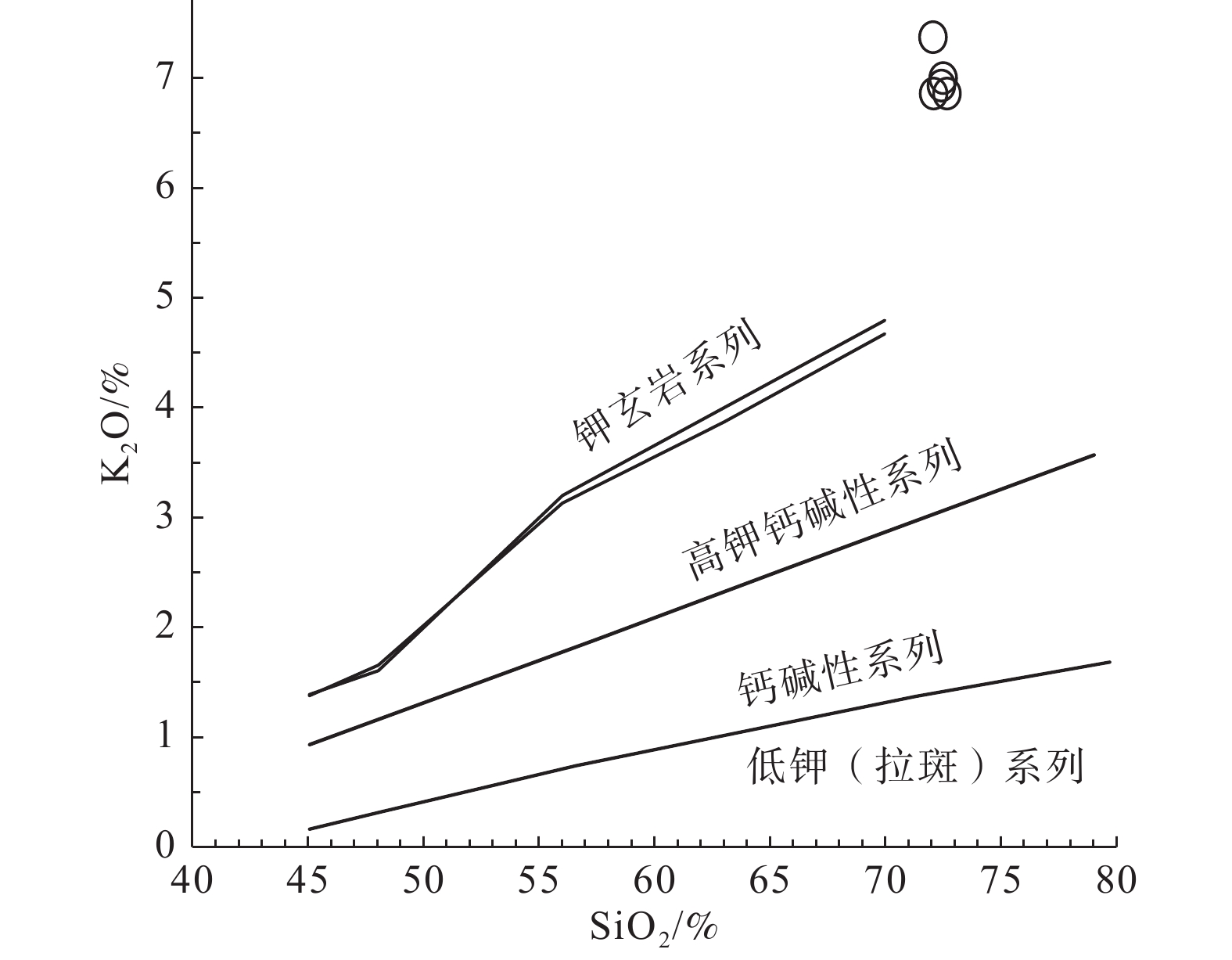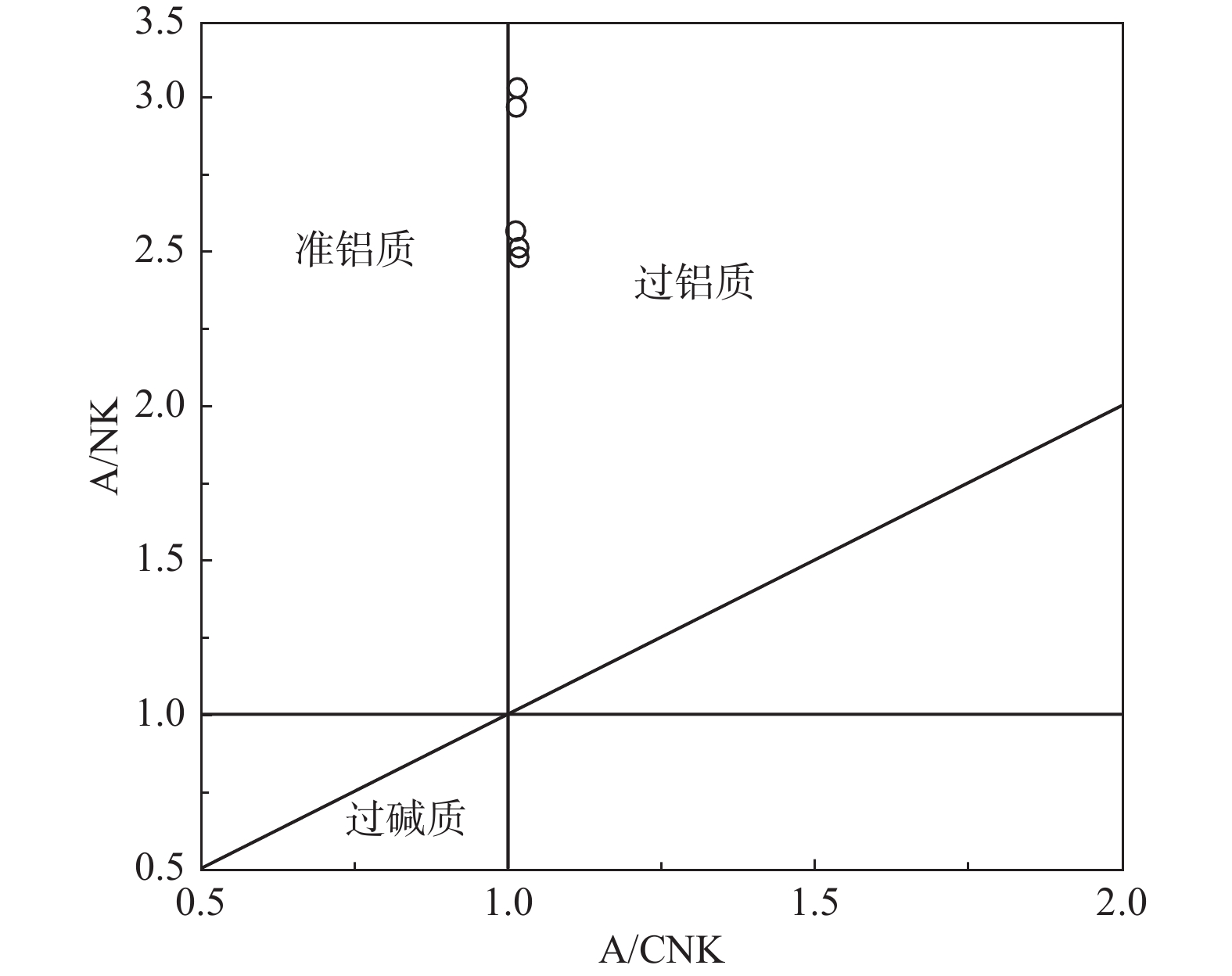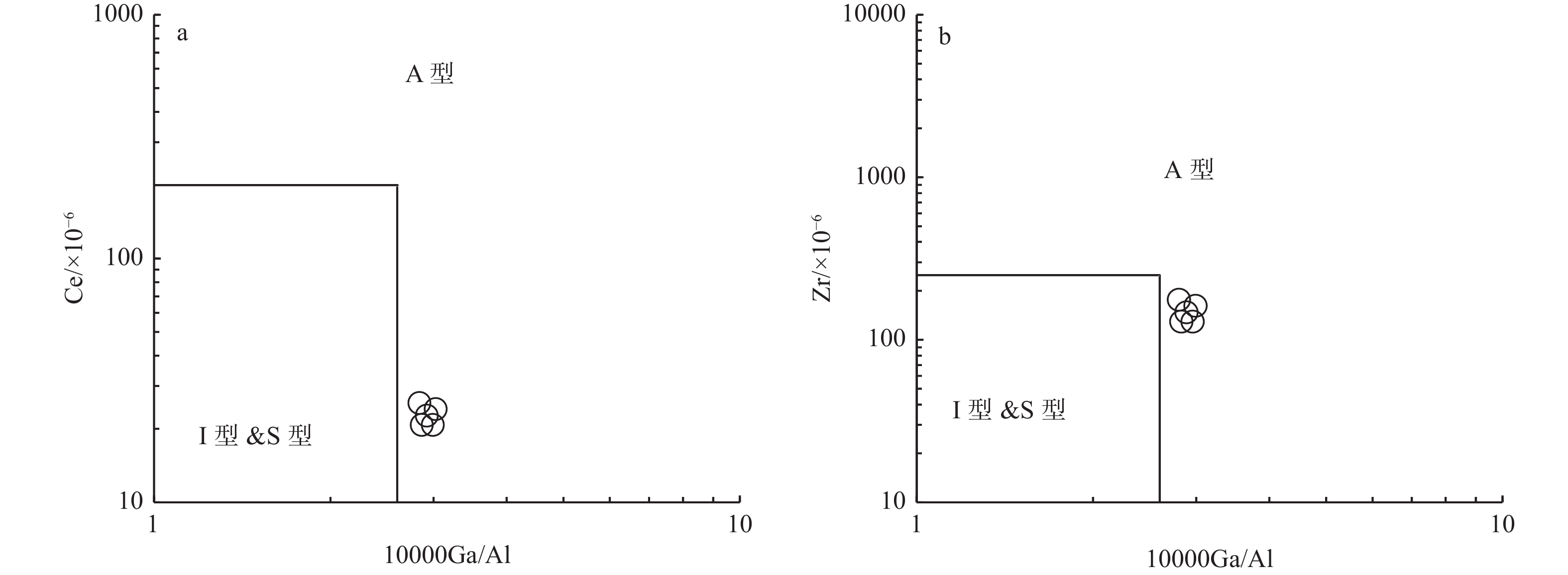The initial time of the Fen–Wei graben system: Constraints from geochronology of the Qifeng granite porphyry dikes in the Zhongtiaoshan Mountains
-
摘要:
汾渭地堑系是华北克拉通中部新生代一条重要的张性断陷带,以往研究成果主要集中在其形成过程及动力学机制方面,但对其开启时限的研究由于缺乏定量的测年对象,一直悬而未解。此次研究在汾渭地堑系相邻的中条山奇峰一带发现了一系列不规则状的花岗斑岩岩脉。对该套花岗斑岩岩脉的测年结果表明,其年龄序列主要集中在1769.8±8.7 Ma和69.14±0.85 Ma两个阶段,前者与熊耳群火山岩的主体年龄一致,代表了继承性锆石的特点,后者代表了花岗斑岩岩脉的形成年龄。奇峰花岗斑岩岩脉样品的Ga/Al均大于2.6,表现富硅、碱、钾,贫钙,高镁的特点,稀土元素中轻稀土富集、重稀土亏损,具有A型花岗岩的特点,形成于拉张的构造背景下。结合区域地质背景认为,该套花岗斑岩岩脉指示了汾渭地堑系南段开启的时限,研究成果为汾渭地堑系的开启时限提供了新的证据。
Abstract:The Fen–Wei graben system is an essential Cenozoic extensional fault–depression belt in the central part of the North China craton. Previous research achievements mainly focused on its formation process and dynamic mechanism, but the initial time has been unresolved due to the lack of quantitative dating objects. This paper first reports the granite porphyry dikes in the andesite of the Majiahe formation in the Xionger group of the Zhongtiaoshan orogenic belt adjacent to the Fen–Wei graben system. The dating results of the granite porphyry dikes indicate that the age sequence concentrates mainly in two stages, 1769.8 ± 8.7 Ma and 69.14 ± 0.85 Ma. The former is consistent with the primary age of the volcanic rocks of the Xionger group, representing the characteristics of inherited zircons, and the latter represents the formation age of the granite porphyry dikes. The Ga/Al value ratios of granite porphyry dikes of the Qifeng samples are all greater than 2.6, characterized by enriched silicon, alkali, potassium, depleted calcium, and high magnesium. The rare earth elements are enriched in light and depleted in heavy rare earth elements. The Qifeng granite porphyrite dikes are I-type granites, indicating that the tectonic setting is extensional. The research provides new evidence for the initial time of the southern part of Fenwei graben in the Cenozoic.
-

-
图 6 奇峰花岗斑岩岩脉TAS图解(Middlemost,1994)
Figure 6.
图 7 奇峰花岗斑岩岩脉SiO2−K2O 图解(Peccerillo and Taylor,1976)
Figure 7.
图 8 奇峰花岗斑岩岩脉A/CNK−A/NK图解(Maniar and Piccoli,1989)
Figure 8.
图 10 A型花岗岩判别图解(Whalen et al.,1987)
Figure 10.
表 1 中条山奇峰花岗斑岩岩脉锆石U-Pb年龄统计表
Table 1. Zircon U–Pb ages of the Qifeng granite porphyry dikes in the Zhongtiaoshan Mountains
样点 元素含量与比值 年龄/Ma Pb/×10−6 U/×10−6 Th/U 207Pb/206Pb 206Pb/238U 1σ 208Pb/232Th 207Pb/206Pb 1σ 206Pb/238U 1σ HB109-01 76 2175 0.80 0.0771 0.0056 0.0111 0.0002 75 5 71 1 HB109-02 109 3280 0.78 0.0831 0.0041 0.0109 0.0002 81 4 70 1 HB109-03 17 35 1.29 4.5705 0.1276 0.3197 0.0042 1744 23 1788 20 HB109-04 49 99 1.24 4.5763 0.0785 0.3163 0.0030 1745 14 1771 15 HB109-05 16 35 1.12 4.6420 0.1306 0.3227 0.0052 1757 24 1803 25 HB109-06 33 963 0.76 0.0775 0.0061 0.0106 0.0003 76 6 68 2 HB109-07 197 5478 0.90 0.0737 0.0038 0.0108 0.0002 72 4 69 1 HB109-08 50 110 0.98 4.6438 0.0862 0.3158 0.0030 1757 16 1769 15 HB109-09 17 38 0.87 4.6591 0.1295 0.3177 0.0042 1760 23 1778 20 HB109-10 18 37 1.27 4.6675 0.1179 0.3156 0.0036 1761 21 1768 18 HB109-11 3 19 1.16 0.0613 0.0056 0.0110 0.0003 60 5 70 2 HB109-12 33 69 1.19 4.6763 0.1037 0.3127 0.0036 1763 19 1754 18 HB109-13 17 35 1.20 4.7256 0.1494 0.3151 0.0047 1772 26 1766 23 HB109-14 16 34 1.05 4.8055 0.1302 0.3217 0.0042 1786 23 1798 21 HB109-15 7 509 0.84 0.0649 0.0079 0.0108 0.0004 64 8 70 3 HB109-16 140 4085 0.82 0.0789 0.0061 0.0108 0.0002 77 6 69 1 HB109-17 8 734 0.33 0.0685 0.0037 0.0104 0.0002 67 3 67 1 HB109-18 9 605 0.59 0.0749 0.0045 0.0111 0.0002 73 4 71 2 HB109-19 11 23 1.09 4.5366 0.1587 0.3086 0.0042 1738 29 1734 21 HB109-20 125 24169 0.16 0.0686 0.0022 0.0106 0.0003 67 2 68 2 HB109-21 10 1726 0.23 0.0690 0.0064 0.0106 0.0004 68 6 68 2 HB109-22 12 2019 0.18 0.0705 0.0024 0.0109 0.0004 69 2 70 2 表 2 奇峰花岗斑岩岩脉主量元素含量/%
Table 2. Principal element contents (w%) of the Qifeng granite porphyry dikes
QF-1-1 QF-1-2 QF-1-3 QF-1-4 QF-1-5 SiO2 71.87 72.80 71.99 72.35 72.70 Al2O3 8.53 8.06 8.88 8.55 8.48 FeO 3.35 3.88 3.16 3.17 3.64 MgO 2.46 2.87 2.92 2.90 2.51 CaO 4.45 2.50 2.73 2.76 3.88 Na2O 2.92 2.38 2.98 2.37 2.91 K2O 3.31 4.38 4.55 4.48 4.78 MnO 0.22 0.08 0.08 0.07 0.21 P2O5 0.05 0.07 0.08 0.07 0.11 TiO2 0.14 0.28 0.31 0.30 0.35 LOI 1.76 1.28 1.39 1.42 0.67 TAL 99.06 98.59 99.09 98.44 100.25 A/CNK 1.07 1.02 1.02 1.08 1.05 Mg# 0.44 0.55 0.71 0.68 0.73 表 3 奇峰花岗斑岩岩脉稀土与微量元素含量/×10−6
Table 3. Rare earth and trace element composotions (w%) of the Qifeng granite porphyry dikes
QF-1-1 QF-1-2 QF-1-3 QF-1-4 QF-1-5 La 7.46 7.65 8.26 5.71 11.64 Ce 14.44 19.60 20.34 14.16 23.40 Pr 1.85 2.20 2.36 1.96 3.02 Nd 8.11 10.06 10.38 9.03 13.09 Sm 2.48 2.48 2.28 2.19 2.80 Eu 0.76 0.76 0.73 0.68 0.89 Gd 1.81 2.28 2.16 1.93 2.64 Tb 0.27 0.38 0.37 0.33 0.45 Dy 1.45 2.43 2.18 2.01 2.68 Ho 0.24 0.47 0.43 0.38 0.53 Er 0.55 1.26 1.16 1.08 1.40 Tm 0.09 0.22 0.20 0.19 0.25 Yb 0.57 1.47 1.26 1.29 1.54 Lu 0.07 0.22 0.19 0.19 0.23 Y 8.64 13.49 11.97 12.11 14.48 LREE 34.47 42.75 44.35 33.73 54.83 HREE 8.36 8.73 7.96 7.40 9.73 δEu 0.95 0.96 0.99 1.00 0.98 δCe 0.91 1.14 1.09 1.02 0.93 REE 54.47 64.96 64.29 53.24 79.04 (La/Yb)N 3.21 3.50 4.42 2.99 5.09 (La/Sm)N 2.50 1.94 2.27 1.64 2.62 Ba 2782.40 13293.66 6010.51 17958.84 2069.59 Cr 13.49 23.66 22.56 25.14 25.72 Cs 0.47 1.06 1.11 1.04 1.19 Ga 4.52 6.87 6.82 6.91 8.88 Hf 0.79 3.88 3.94 3.79 3.65 Nb 3.40 3.05 4.04 3.05 6.14 Pb 3.04 3.41 4.11 2.86 3.91 Rb 37.36 40.78 42.31 40.62 46.22 Sr 81.17 199.24 69.65 285.01 38.35 Ta 0.04 0.11 0.15 0.16 0.19 Th 0.28 0.70 1.33 1.60 1.94 U 0.86 1.30 1.54 1.23 1.76 Zr 123.31 127.93 125.35 127.25 122.86 -
[1] ANDERSEN T, 2002. Correction of common lead in U-Pb analyses that do not report 204Pb[J]. Chemical Geology, 192(1-2): 59-79. doi: 10.1016/S0009-2541(02)00195-X
[2] BATCHELOR R A, BOWDEN P, 1985. Petrogenetic interpretation of granitoid rock series using multicationic parameters[J]. Chemical Geology, 48(1-4): 43-55. doi: 10.1016/0009-2541(85)90034-8
[3] BELLIER O, MERCIER J L, VERGELY P, et al. , 1988. Evolution sédimentaire et tectonique du graben cénozoïque de la Wei He (province du Shaanxi, Chine du Nord)[J]. Bulletin de la Société Géologique de France, IV(6): 979-994.
[4] BELLIER O, VERGELY P, MERCIER J L, et al. , 1991. Analyse tectonique et sédimentaire dans les monts Li Shan (province du Shaanxi, Chine du Nord); datation des régimes tectoniques extensifs dans le graben de la Wei He[J]. Bulletin de la Société Géologique de France, 162(1): 101-112.
[5] CHAPPELL B W, WHITE A J R, WYBORN D, 1987. The importance of residual source material (restite) in granite petrogenesis[J]. Journal of Petrology, 28(6): 1111-1138. doi: 10.1093/petrology/28.6.1111
[6] CHEN H, HU J M, WU G L, et al. , 2015. Apatite fission-track thermochronological constraints on the pattern of Late Mesozoic–Cenozoic uplift and exhumation of the Qinling Orogen, Central China[J]. Journal of Asian Earth Sciences, 114: 649-673. doi: 10.1016/j.jseaes.2014.10.004
[7] CHEN X Q, 2017. Sedimentary and tectonic evolution of the Cenozoic Weihe-Shanxi Graben and the mechanism[D]. Beijing: Peking University. (in Chinese with English abstract)
[8] CHEN X Q, DONG S W, SHI W, et al. , 2021. Magnetostratigraphic ages of the Cenozoic Weihe and Shanxi Grabens in North China and their tectonic implications[J]. Tectonophysics, 813: 228914. doi: 10.1016/j.tecto.2021.228914
[9] CUI M L, ZHANG B L, ZHANG L C, 2011. U–Pb dating of baddeleyite and zircon from the Shizhaigou diorite in the southern margin of North China Craton: constrains on the timing and tectonic setting of the Paleoproterozoic Xiong'er Group[J]. Gondwana Research, 20(1): 184-193. doi: 10.1016/j.gr.2011.01.010
[10] CUI X F, XIE F R, LI R S, et al. , 2010. Heterogeneous features of state of tectonic stress filed in North China and deep stress in coal mine[J]. Chinese Journal of Rock Mechanics and Engineering, 29(S1): 2755-2761. (in Chinese with English abstract)
[11] GAO F, WANG Y J, LIU S S, et al. , 2000. Thermal history study in the west of the Ordos Basin using apatite fission track analysis[J]. Geotectonica et Metallogenia, 24(1): 87-91. (in Chinese with English abstract)
[12] HAN X M, LIU F, ZHANG W T, et al. , 2015. Analyzing the variation characteristics of stress field in Hetao seismic belt using focal mechanism data[J]. Seismology and Geology, 37(4): 1030-1042. (in Chinese with English abstract)
[13] HOU G T, WANG C C, LI J H, et al. , 2006. Late Paleoproterozoic extension and a paleostress field reconstruction of the North China Craton[J]. Tectonophysics, 422(1-4): 89-98,doi: 10.1016/j.tecto.2006.05.008.
[14] LI B, 2019. Thrust structure and its effect on hydrocarbon in the western margin of Ordos Basin[D]. Xi’an: Northwest University. (in Chinese with English abstract)
[15] LIANG G H, 2023. Genesis of the Baikal Rift and the Fenwei graben and the remote effects of the Indo-Eurasian collision[J]. Earth Science Frontiers, 30(3): 282-293. (in Chinese with English abstract)
[16] LIN X D, YUAN H Y, XU P, et al. , 2017. Zonational characteristics of earthquake focal mechanism solutions in North China[J]. Chinese Journal of Geophysics, 60(12): 4589-4622. (in Chinese with English abstract)
[17] LIU C Y, ZHAO H G, GUI X J, et al. , 2006. Space-time coordinate of the evolution and reformation and mineralization response in Ordos Basin[J]. Acta Geologica Sinica, 80(5): 617-638. (in Chinese with English abstract)
[18] LIU H J, XUE X X, 2004. Discussion on the Cenozoic and its chronology in the Weihe River Basin[J]. Journal of Earth Sciences and Environment, 26(4): 1-5. (in Chinese with English abstract)
[19] LIU J H, ZHANG P Z, ZHENG D W, et al. , 2010. The cooling history of Cenozoic exhumation and uplift of the Taibai Mountain, Qinling, China: evidence from the apatite fission track (AFT) analysis[J]. Chinese Journal of Geophysics, 53(10): 2405-2414. (in Chinese with English abstract)
[20] LIU J H, ZHANG P Z, LEASE R O, et al. , 2013. Eocene onset and Late Miocene acceleration of Cenozoic intracontinental extension in the North Qinling range–Weihe graben: Insights from apatite fission track thermochronology[J]. Tectonophysics, 584: 281-296. doi: 10.1016/j.tecto.2012.01.025
[21] LIU Y S, HU Z C, ZONG K Q, et al. , 2010. Reappraisement and refinement of zircon U-Pb isotope and trace element analyses by LA-ICP-MS[J]. Chinese Science Bulletin, 55(15): 1535-1546. doi: 10.1007/s11434-010-3052-4
[22] LOISELLE M C, WONES D R, 1979. Characteristics and origin of anorogenic granites[J]. Abstracts with Programs - Geological Society of America, 12(7): 468.
[23] LUDWIG K R, 2003. ISOPLOT 3.00: a geochronological toolkit for Microsoft excel[M]. Berkeley: Berkeley Geochronology Center: 39.
[24] MANIAR P D, PICCOLI P M. 1989.Tectonic discrimination of granitoids[J]. Geological society of America bulletin, 101(5): 635-643.
[25] MERCIER J L, VERGELY P, ZHANG Y Q, et al. , 2013. Structural records of the Late Cretaceous-Cenozoic extension in Eastern China and the kinematics of the Southern Tan-Lu and Qinling Fault Zone (Anhui and Shaanxi Provinces, PR China)[J]. Tectonophysics, 582: 50-75. doi: 10.1016/j.tecto.2012.09.015
[26] MIDDLEMOST E A K, 1994. Naming materials in the magma/igneous rock system[J]. Earth-Science Reviews, 37(3-4): 215-224. doi: 10.1016/0012-8252(94)90029-9
[27] PEARCE J A, HARRIS N B W, TINDLE A G, 1984. Trace element discrimination diagrams for the tectonic interpretation of granitic rocks[J]. Journal of Petrology, 25(4): 956-983. doi: 10.1093/petrology/25.4.956
[28] PECCERILLO A, TAYLOR S R, 1976. Geochemistry of Eocene calc-alkaline volcanic rocks from the Kastamonu area, northern Turkey[J]. Contributions to Mineralogy and Petrology, 58(1): 63-81. doi: 10.1007/BF00384745
[29] PENG P, ZHAI M G, ERNST R E, et al. , 2008. A 1.78 Ga large igneous province in the North China Craton: the Xiong'er Volcanic province and the North China dyke swarm[J]. Lithos, 101(3-4): 260-280. doi: 10.1016/j.lithos.2007.07.006
[30] QI K, REN Z L, CUI J P, et al. , 2017. The Meso-Cenozoic tectonic thermal evolution of the Qishan-Linyou areas in Weibei uplift of Ordos Basin and its response in geology: evidence from fission-track analysis[J]. Acta Geologica Sinica, 91(1): 151-162. (in Chinese with English abstract)
[31] QIN B C, FANG W X, ZHANG J G, et al. , 2021. Quaternary sedimentary sequence and sedimentary environment restoration in the Jinzhong Basin, Fenhe Rift Valley[J]. Journal of Geomechanics, 27(6): 1035-1050. (in Chinese with English abstract)
[32] Shanxi Province Stratigraphic Table Compiling Group, 1979. North China regional stratigraphic table Shanxi Province division[M]. Beijing: Geology Press. (in Chinese)
[33] Shanxi Provincial Geological Prospecting Bureau, 1989. Regional geology of Shanxi province[M]. Beijing: Geology Press. (in Chinese)
[34] SHI W, DONG S W, LIU Y, et al. , 2015. Cenozoic tectonic evolution of the South Ningxia region, northeastern Tibetan Plateau inferred from new structural investigations and fault kinematic analyses[J]. Tectonophysics, 649: 139-164. doi: 10.1016/j.tecto.2015.02.024
[35] SHI W, DONG S W, HU J M, 2020. Neotectonics around the Ordos Block, North China: a review and new insights[J]. Earth-Science Reviews, 200: 102969. doi: 10.1016/j.earscirev.2019.102969
[36] SONG Y G, QIAN L B, LI Y, 2013. Fission track evidence of tectonic uplift in Liupanshan area since Cretaceous[C]//Proceedings of the First National Youth Geological Congress. Fuzhou: Editorial Department of Geological Journal of the Chinese Geological Society: 121-124. (in Chinese)
[37] SU P, HE H L, TAN X B, et al. , 2021. Initiation and evolution of the Shanxi rift system in North China: Evidence from low-temperature thermochronology in a plate reconstruction framework[J]. Tectonics, 40(3): e2020TC006298.
[38] SU Z Z, 1988. New tectonic background of seismic activity in Shanxi fault depression zone[J]. Shanxi Earthquakes(4): 2-6. (in Chinese)
[39] SUN S H, LI X M, GONG G L, et al. , 1997. Study on tectonic thermal events in Ordos Basin[J]. Chinese Science Bulletin, 42(3): 306-309. (in Chinese) doi: 10.1360/csb1997-42-3-306
[40] SUN S S, MCDONOUGH W F, 1989. Chemical and isotopic systematics of oceanic basalts: Implications for mantle composition and processes[M]//SAUNDERS A D, NORRY M J. Magmatism in the ocean basins. London: Geological Society, London, Special Publications, 42(1): 313-345.
[41] SYLVESTER P J, 1989. Post-collisional alkaline granites[J]. The Journal of Geology, 97(3): 261-280. doi: 10.1086/629302
[42] WAN T F, 2004. Outline of Chinese geotectonics[M]. Beijing: Geology Press: 387. (in Chinese)
[43] WAN Y S, DONG C Y, XIE H Q, et al. , 2022. Huge growth of the Late Mesoarchean–early Neoarchean (2.6~3.0 Ga) continental crust in the North China Craton: a review[J]. Journal of Geomechanics, 28(5): 866-906. (in Chinese with English abstract)
[44] WANG J Q, 2010. Mesozoic-Cenozoic basin evolution-reforming and basin-mountain coupling in southern Ordos Basin[D]. Xi’an: Northwest University. (in Chinese with English abstract)
[45] WANG Q, ZHAO Z H, XIONG X L, 2000. The ascertainment of Late-Yanshanian A-type granite in Tongbai-Dabie Orogenic belt[J]. Acta Petrologica et Mineralogica, 19(4): 297-306. (in Chinese with English abstract)
[46] WANG S, ZHANG S H, ZHANG Q Q, et al. , 2022. In-situ zircon U-Pb dating method by LA-ICP-MS and discussions on the effect of different beam spot diameters on the dating results[J]. Journal of Geomechanics, 28(4): 642-652. (in Chinese with English abstract)
[47] WANG X F, LI D W, DU Y S, et al. , 2015. Zircon U-Pb dating of the sub-volcanic rocks dismantled from Gaoshanhe and Yunmengshan formations in southern margin of North China Craton[J]. Geotectonica et Metallogenia, 39(5): 919-932. (in Chinese with English abstract)
[48] WHALEN J B, CURRIE K L, CHAPPELL B W, 1987. A-type granites: geochemical characteristics, discrimination and petrogenesis[J]. Contributions to Mineralogy and Petrology, 95(4): 407-419. doi: 10.1007/BF00402202
[49] WU M J, LIN X D, XU P, 2011. Analysis of focal mechanism and tectonic stress field features in northern part of North China[J]. Journal of Geodesy and Geodynamics, 31(5): 39-43. (in Chinese with English abstract)
[50] WU Q, XU L Q, LI S Z, et al. , 2013. Active tectonics in the central North China Block and the cause of the formation of the Fenwei Graben[J]. Earth Science Frontiers, 20(4): 104-114. (in Chinese with English abstract)
[51] WU Z H, WU Z H, WAN J L, et al. , 2003. Cenezoic uplift and denudation history of Huashan Mountains: evidence from fission track thermo-chronology of Huashan granite[J]. Geological Science and Technology Information, 22(3): 27-32. (in Chinese with English abstract)
[52] XING Z Y, ZHAO B, TU M Y, et al. , 2005. The formation of the Fenwei rift valley[J]. Earth Science Frontiers, 12(2): 247-262. (in Chinese with English abstract)
[53] XU X W, MA X Y, DENG Q D, 1993. Neotectonic activity along the Shanxi rift system, China[J]. Tectonophysics, 219(4): 305-325. doi: 10.1016/0040-1951(93)90180-R
[54] YANG Z, SHEN C B, RATSCHBACHER L, et al. , 2017. Sichuan Basin and beyond: eastward foreland growth of the Tibetan Plateau from an integration of Late Cretaceous-Cenozoic fission track and (U-Th)/He ages of the eastern Tibetan Plateau, Qinling, and Daba Shan[J]. Journal of Geophysical Research: Solid Earth, 122(6): 4712-4740. doi: 10.1002/2016JB013751
[55] YUAN B Y, TANG G A, ZHOU L P, et al. , 2012. Control action on the geomorphic differentiation in loess plateau and the formation of Yellow River by Cenozoic tectogenesis[J]. Quaternary Sciences, 32(5): 829-838. (in Chinese with English abstract)
[56] ZHANG Y Q, MERCIER J L, VERGéLY P, 1998. Extension in the graben systems around the Ordos (China), and its contribution to the extrusion tectonics of South China with respect to Gobi-Mongolia[J]. Tectonophysics, 285(1-2): 41-75. doi: 10.1016/S0040-1951(97)00170-4
[57] ZHONG Q M, SHAO B, HOU G T, 2022. Numerical simulation and analysis of lithospheric stress field in Fenwei graben[J]. Progress in Geophysics, 37(1): 152-163. (in Chinese with English abstract)
[58] ZHU D G, MENG X G, SHAO Z G, et al. , 2008. Revision and classification of Paleogene fluvial-lacustrine strata in the Pinglu area, Shanxi[J]. Geology in China, 35(4): 656-669. (in Chinese with English abstract)
[59] ZHU R X, ZHANG H F, ZHU G, et al. , 2017. Craton destruction and related resources[J]. International Journal of Earth Sciences, 106(7): 2233-2257. doi: 10.1007/s00531-016-1441-x
[60] 陈兴强, 2017. 汾渭地堑系新生代沉积-构造演化及其形成机制[D]. 北京: 北京大学.
[61] 崔效锋, 谢富仁, 李瑞莎, 等, 2010. 华北地区构造应力场非均匀特征与煤田深部应力状态[J]. 岩石力学与工程学报, 29(S1): 2755-2761.
[62] 高峰, 王岳军, 刘顺生, 等, 2000. 利用磷灰石裂变径迹研究鄂尔多斯盆地西缘热历史[J]. 大地构造与成矿学, 24(1): 87-91.
[63] 韩晓明, 刘芳, 张文韬, 等, 2015. 基于震源机制资料分析河套地震带的应力场变化特征[J]. 地震地质, 37(4): 1030-1042.
[64] 李斌, 2019. 鄂尔多斯盆地西部冲断带构造与控油气因素研究[D]. 西安: 西北大学.
[65] 梁光河, 2023. 贝加尔裂谷和汾渭地堑成因与印度-欧亚碰撞的远程效应[J]. 地学前缘, 30(3): 282-293.
[66] 林向东, 袁怀玉, 徐平, 等, 2017. 华北地区地震震源机制分区特征[J]. 地球物理学报, 60(12): 4589-4622. doi: 10.6038/cjg20171206
[67] 刘池洋, 赵红格, 桂小军, 等, 2006. 鄂尔多斯盆地演化-改造的时空坐标及其成藏(矿)响应[J]. 地质学报, 80(5): 617-638. doi: 10.3321/j.issn:0001-5717.2006.05.001
[68] 刘护军, 薛祥煦, 2004. 对渭河盆地新生界及其年代的讨论[J]. 地球科学与环境学报, 26(4): 1-5.
[69] 刘建辉, 张培震, 郑德文, 等, 2010. 秦岭太白山新生代隆升冷却历史的磷灰石裂变径迹分析[J]. 地球物理学报, 53(10): 2405-2414.
[70] 祁凯, 任战利, 崔军平, 等, 2017. 鄂尔多斯盆地渭北隆起岐山-麟游地区中新生代构造热演化及地质响应: 来自裂变径迹分析的证据[J]. 地质学报, 91(1): 151-162.
[71] 秦帮策, 方维萱, 张建国, 等, 2021. 汾河裂谷晋中盆地内第四纪沉积序列与沉积环境恢复[J]. 地质力学学报, 27(6): 1035-1050.
[72] 山西省地层表编写组, 1979. 华北地区区域地层表 山西省分册[M]. 北京: 地质出版社.
[73] 山西省地质矿产局, 1989. 山西省区域地质志[M]. 北京: 地质出版社.
[74] 宋友桂, 千琳勃, 李云, 2013. 白垩纪以来六盘山地区构造隆升的裂变径迹证据[C]//第一届全国青年地质大会论文集. 福州: 中国地质学会地质学报编辑部: 121-124.
[75] 苏宗正, 1988. 山西断陷带地震活动的新构造背景[J]. 山西地震(4): 2-6.
[76] 孙少华, 李小明, 龚革联, 等, 1997. 鄂尔多斯盆地构造热事件研究[J]. 科学通报, 42(3): 306-309.
[77] 万天丰, 2004. 中国大地构造学纲要[M]. 北京: 地质出版社: 387.
[78] 万渝生, 董春艳, 颉颃强, 等, 2022. 华北克拉通新太古代早期—中太古代晚期(2.6~3.0 Ga)巨量陆壳增生: 综述[J]. 地质力学学报, 28(5): 866-906.
[79] 王建强, 2010. 鄂尔多斯盆地南部中新生代演化—改造及盆山耦合关系[D]. 西安: 西北大学.
[80] 王强, 赵振华, 熊小林, 2000. 桐柏—大别造山带燕山晚期A型花岗岩的厘定[J]. 岩石矿物学杂志, 19(4): 297-306.
[81] 王森, 张拴宏, 张琪琪, 等, 2022. LA-ICP-MS锆石微区U-Pb定年方法及不同束斑直径对年龄结果的影响作用探讨[J]. 地质力学学报, 28(4): 642-652.
[82] 汪校锋, 李德威, 杜远生, 等, 2015. 华北南缘高山河组和云梦山组中解体的次火山岩: 锆石U-Pb定年[J]. 大地构造与成矿学, 39(5): 919-932.
[83] 武敏捷, 林向东, 徐平, 2011. 华北北部地区震源机制解及构造应力场特征分析[J]. 大地测量与地球动力学, 31(5): 39-43. doi: 10.3969/j.issn.1671-5942.2011.05.009
[84] 吴奇, 许立青, 李三忠, 等, 2013. 华北地块中部活动构造特征及汾渭地堑成因探讨[J]. 地学前缘, 20(4): 104-114.
[85] 吴中海, 吴珍汉, 万景林, 等, 2003. 华山新生代隆升-剥蚀历史的裂变径迹热年代学分析[J]. 地质科技情报, 22(3): 27-32.
[86] 邢作云, 赵斌, 涂美义, 等, 2005. 汾渭裂谷系与造山带耦合关系及其形成机制研究[J]. 地学前缘, 12(2): 247-262. doi: 10.3321/j.issn:1005-2321.2005.02.027
[87] 袁宝印, 汤国安, 周力平, 等, 2012. 新生代构造运动对黄土高原地貌分异与黄河形成的控制作用[J]. 第四纪研究, 32(5): 829-838.
[88] 仲启蒙, 邵博, 侯贵廷, 2022. 汾渭地堑岩石圈的应力场数值模拟与分析[J]. 地球物理学进展, 37(1): 152-163.
[89] 朱大岗, 孟宪刚, 邵兆刚, 等, 2008. 山西平陆地区古近纪河湖相地层的重新厘定与划分[J]. 中国地质, 35(4): 656-669.
-




 下载:
下载:
